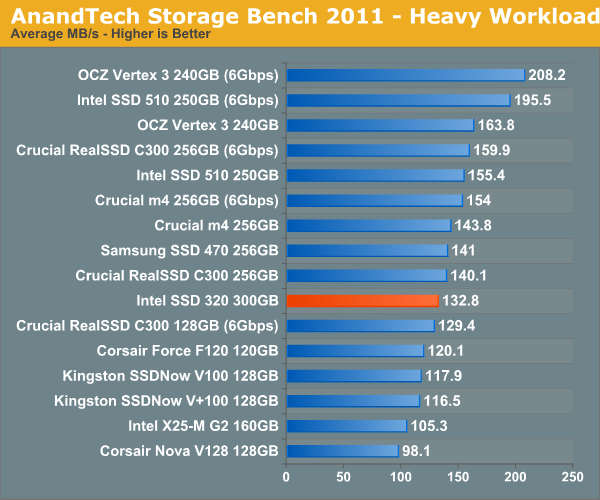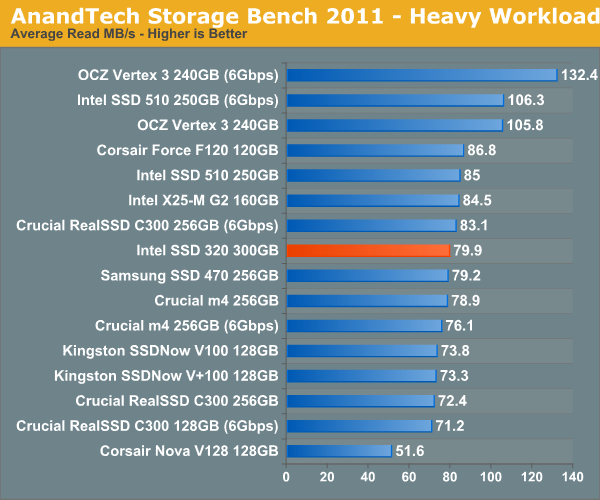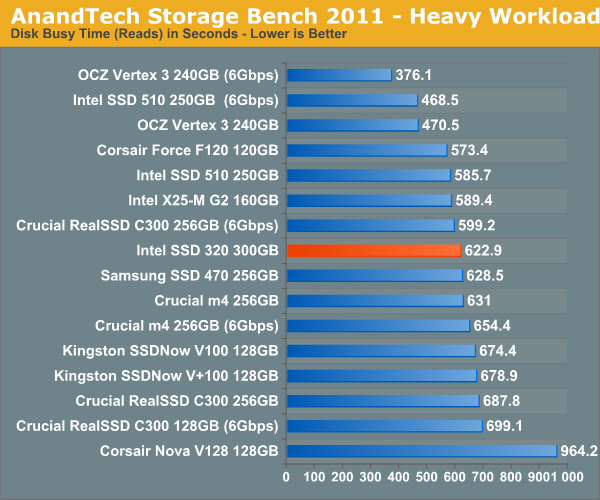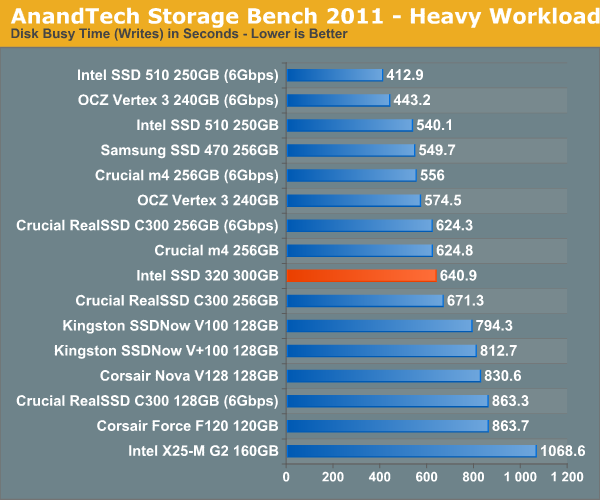The Intel SSD 320 Review: 25nm G3 is Finally Here
by Anand Lal Shimpi on March 28, 2011 11:08 AM EST- Posted in
- IT Computing
- Storage
- SSDs
- Intel
- Intel SSD 320
AnandTech Storage Bench 2011: Much Heavier
I didn't expect to have to debut this so soon, but I've been working on updated benchmarks for 2011. Last year we introduced our AnandTech Storage Bench, a suite of benchmarks that took traces of real OS/application usage and played them back in a repeatable manner. I assembled the traces myself out of frustration with the majority of what we have today in terms of SSD benchmarks.
Although the AnandTech Storage Bench tests did a good job of characterizing SSD performance, they weren't stressful enough. All of the tests performed less than 10GB of reads/writes and typically involved only 4GB of writes specifically. That's not even enough exceed the spare area on most SSDs. Most canned SSD benchmarks don't even come close to writing a single gigabyte of data, but that doesn't mean that simply writing 4GB is acceptable.
Originally I kept the benchmarks short enough that they wouldn't be a burden to run (~30 minutes) but long enough that they were representative of what a power user might do with their system.
Not too long ago I tweeted that I had created what I referred to as the Mother of All SSD Benchmarks (MOASB). Rather than only writing 4GB of data to the drive, this benchmark writes 106.32GB. It's the load you'd put on a drive after nearly two weeks of constant usage. And it takes a *long* time to run.
I'll be sharing the full details of the benchmark in some upcoming SSD articles but here are some details:
1) The MOASB, officially called AnandTech Storage Bench 2011 - Heavy Workload, mainly focuses on the times when your I/O activity is the highest. There is a lot of downloading and application installing that happens during the course of this test. My thinking was that it's during application installs, file copies, downloading and multitasking with all of this that you can really notice performance differences between drives.
2) I tried to cover as many bases as possible with the software I incorporated into this test. There's a lot of photo editing in Photoshop, HTML editing in Dreamweaver, web browsing, game playing/level loading (Starcraft II & WoW are both a part of the test) as well as general use stuff (application installing, virus scanning). I included a large amount of email downloading, document creation and editing as well. To top it all off I even use Visual Studio 2008 to build Chromium during the test.
Many of you have asked for a better way to really characterize performance. Simply looking at IOPS doesn't really say much. As a result I'm going to be presenting Storage Bench 2011 data in a slightly different way. We'll have performance represented as Average MB/s, with higher numbers being better. At the same time I'll be reporting how long the SSD was busy while running this test. These disk busy graphs will show you exactly how much time was shaved off by using a faster drive vs. a slower one during the course of this test. Finally, I will also break out performance into reads, writes and combined. The reason I do this is to help balance out the fact that this test is unusually write intensive, which can often hide the benefits of a drive with good read performance.
There's also a new light workload for 2011. This is a far more reasonable, typical every day use case benchmark. Lots of web browsing, photo editing (but with a greater focus on photo consumption), video playback as well as some application installs and gaming. This test isn't nearly as write intensive as the MOASB but it's still multiple times more write intensive than what we were running last year.
As always I don't believe that these two benchmarks alone are enough to characterize the performance of a drive, but hopefully along with the rest of our tests they will help provide a better idea.
The testbed for Storage Bench 2011 has changed as well. We're now using a Sandy Bridge platform with full 6Gbps support for these tests. All of the older tests are still run on our X58 platform.
AnandTech Storage Bench 2011 - Heavy Workload
We'll start out by looking at average data rate throughout our new heavy workload test:

Overall performance is decidedly last generation. The 320 is within striking distance of the 510 but is slower overall in our heavy workload test.
The breakdown of reads vs. writes tells us more of what's going on:


The next three charts just represent the same data, but in a different manner. Instead of looking at average data rate, we're looking at how long the disk was busy for during this entire test. Note that disk busy time excludes any and all idles, this is just how long the SSD was busy doing something:













194 Comments
View All Comments
Morten.DK - Monday, April 11, 2011 - link
One thing that bothers me a bit: It seems that the smaller drives has a lower spare area percentage than the 300GB drive.120GB: Physical 120GB, user capacity 111GB, spare ares 9GB which is 7.5%
160GB: Physical 160GB, user capacity 149GB, spare area 11GB which is 6.9%
300GB: Physical 320GB, user capacity 279GB, spare area 41GB which is 12.8%
600GB: Phycical 640GB, user capacity 558GB, spare area 82GB which is 12.8%
Does this mean that the smaller drives does not have the same RAID4-like redundancy as the 300GB drive? Or am I wrong about the physival sizes of the smaller drives?
noblemo - Thursday, April 14, 2011 - link
There are two factors in your calculation: 1) spare area, and 2) GB to GiB conversion. I believe the spare area is as follows:120 GB: 128-120 = 8 GB spare area = 6.25%
300 GB: 320-300 = 20 GB spare area = 6.25%
600 GB: 640-600 = 40 GB spare area = 6.25%
I am not sure about the 160GB model; if it uses six 32GB chips, then the spare area is 16.7%. If it uses five 32GB chips, then there is no spare area.
To convert GB to GiB, divide by 1.024^3:
120 GB = 111.8 GiB
160 GB = 149 GiB
300 GB = 279 GiB
600 GB = 559 GiB
So the 120 GB drive has 128 GB total area and 8 GB spare area (6.25%). This is equivalent to 111.8 GiB with 119.2 GiB total area and 7.45 GiB spare area (6.25%).
noblemo - Friday, April 15, 2011 - link
My previous post was incorrect. The 300GB and 600GB drives have 12.8% spare area, while the smaller drives have 6.8%.mattr00 - Sunday, April 17, 2011 - link
Hey Anand,Thanks as always for a great review. Is there any ETA on benchmarking the 120GB version of this? All of the reviews I see online are 300GB and I'm itching to know whether the 120GB performance is significantly lower than the 300GB performance. I'm considering buying the 120GB, but it has lower IOPS write performance than 300GB according to Intel specs, which I fear will mean low random write performance in the real world.
Thanks!
Surlias - Saturday, April 23, 2011 - link
I've been unable to find a review comparing the 40gb G2 and the 40gb G3 models. Anyone have any experience with both of these models, or perhaps can point me to a review of the 40gb G3 somewhere? I'm sitting on an unopened G2 trying to decide if I want to go to the trouble of exchanging it for a G3. I'd save a few bucks in the process, but if the performance isn't any better then I'd just as soon stick with the G2 and its proven reliability.ross999 - Tuesday, April 26, 2011 - link
I know the documentation says that an ATA password is required to use the device level encryption, and that Mac's OS EFI password isn't quite the same. However, I've spoke with both Intel and Apple, and neither can provide any details about compatibility of these passwords for purposes of encryption. Really, Intel, you don't know if it will work with MacOS? Bizarre.Can anyone shed first-hand knowledge on this?
MB17 - Saturday, May 7, 2011 - link
Cost difference is little to consider for me, so if someone can help:On 3 GBPS systems, I understood that the Intel 320 is a little bit better in real life performance than the 510. Is this correct?
Also, 510 is a little more future proof (if I ever change to a 6GBPS system) and 320 gives me more storage space, right?
These seems to be my main points of consideration, right, or am I overlooking something?
Any definitive reason to buy one over the other?
Thanks so much for any help.
PS: How much free space do I get from the 510 (unlike the 320 I could not find this info)
garuda1 - Monday, May 23, 2011 - link
Does anyone know why Intel's Toolbox won't TRIM an SSD mounted in an external enclosure. It will migrate, but won't TRIM. Intel responded in an email by only saying:“We don’t validate or authorize use of SSD Optimizer through eSATA enclosures. If a customer wants to use an eSATA enclosure, they must understand they are using a configuration that is not validated by Intel and they are on their own.
-If customer wants to use Optimizer on an Intel SSD, suggest they connect it directly to the host system."
But is there a specific reason for this? And will Intel eventually modify the Toolbox to accommodate external SSDs in the near future. Once the host system case is full, the only alternative is external enclosures. Is there some design or F/W limitation that precludes externals?
P.S. - Intel's FAQ section on their website specifically mentions that SSDs are compatible with external eSATA enclosures (unless they recently changed it). This is what led me to believe that my recent purchase of two S320 600GB SSDs would function and optimize in external eSATA enclosure which I also purchased. Thanks for any feedback.
garuda1 - Monday, May 23, 2011 - link
Note question and answer# 4 in the following link at Intel FAQs:http://download.intel.com/support/ssdc/hpssd/sb/in...
hoofy - Monday, August 22, 2011 - link
I am really concerned how the 40GB SSD 320 will perform as i am planning to buy it as an OS drive. My other options are vertex 2 40GB and X-25-V 40GB. Please recommend me guys the best drive among these three.